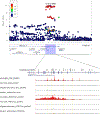Heritability Enrichment Implicates Microglia in Parkinson's Disease Pathogenesis
- PMID: 33502028
- PMCID: PMC9017316
- DOI: 10.1002/ana.26032
Heritability Enrichment Implicates Microglia in Parkinson's Disease Pathogenesis
Abstract
Objective: Understanding how different parts of the immune system contribute to pathogenesis in Parkinson's disease is a burning challenge with important therapeutic implications. We studied enrichment of common variant heritability for Parkinson's disease stratified by immune and brain cell types.
Methods: We used summary statistics from the most recent meta-analysis of genomewide association studies in Parkinson's disease and partitioned heritability using linkage disequilibrium score regression, stratified for specific cell types, as defined by open chromatin regions. We also validated enrichment results using a polygenic risk score approach and intersected disease-associated variants with epigenetic data and expression quantitative loci to nominate and explore a putative microglial locus.
Results: We found significant enrichment of Parkinson's disease risk heritability in open chromatin regions of microglia and monocytes. Genomic annotations overlapped substantially between these 2 cell types, and only the enrichment signal for microglia remained significant in a joint model. We present evidence suggesting P2RY12, a key microglial gene and target for the antithrombotic agent clopidogrel, as the likely driver of a significant Parkinson's disease association signal on chromosome 3.
Interpretation: Our results provide further support for the importance of immune mechanisms in Parkinson's disease pathogenesis, highlight microglial dysregulation as a contributing etiological factor, and nominate a targetable microglial gene candidate as a pathogenic player. Immune processes can be modulated by therapy, with potentially important clinical implications for future treatment in Parkinson's disease. ANN NEUROL 2021;89:942-951.
© 2021 The Authors. Annals of Neurology published by Wiley Periodicals LLC on behalf of American Neurological Association.
Conflict of interest statement
Potential Conflicts of Interest
Nothing to report.
Figures





References
Publication types
MeSH terms
Substances
Grants and funding
LinkOut - more resources
Full Text Sources
Other Literature Sources
Medical

